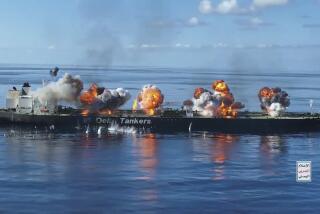Wartime Tanker Sinkings Offer Long-Term View of Oil Spills
- Share via
JACKSONVILLE, Fla. — Tar balls washing up on East Coast beaches may be the legacy of a long-ago war and long-lost oil tankers--a reminder of yesterday’s pollution at a time when today’s spills have the nation on guard.
A half-century ago, German U-boats stalking their prey close by the U.S. Gulf and East coasts sank 148 petroleum tankers and countless other ships, spilling or sending to the ocean bottom millions of gallons of oil and gasoline.
Recent big spills off Alaska and California recall those World War II disasters and invite a basic question: What has been the lasting impact?
The government studied the pollution potential two decades after the war and judged it to be minor. But conclusive answers still remain sketchy.
Nazi Germany unleashed its U-boats in January, 1942, weeks after the United States entered the war. Unarmed ships traveling along the East and Gulf coasts, sometimes silhouetted by shore lights at night, were sitting ducks.
In his 1978 book, “U-Boats Offshore--When Hitler Struck America,” Edwin P. Hoyt estimated that in one month in early 1942, five German submarines cost the Allies hundreds of thousands of gallons of gasoline.
Oil spills were reported up and down the coast during the war. Oil washing ashore was a nuisance for Florida tourists and a headache for resort operators. But there is no evidence any major cleanup efforts were undertaken.
The national focus was on the war effort, not on the environment. In fact, the government censored information on such sinkings.
Environmental officials agree the World War II spills without doubt caused short-term damage, and in some cases sensitive shore areas may have been permanently damaged or destroyed.
But, as one specialist noted, oil usually degrades over two to three years.
“That’s not to say that we want oil spills in the environment, because there’s always a certain amount of toxicity,” said the specialist, Fred Stroud, a senior on-site coordinator for oil spills for the Environmental Protection Agency.
Many tar balls that wash up on the beaches of Florida and the rest of the Southeast could be the result of slow leakage from some of the German-sunk tankers, Stroud said.
The federal government in 1967 studied the potential pollution threat from the World War II sinkings.
Coast Guard divers examined four tankers sunk in less than 200 feet of water off New York and New Jersey and found tanks mostly emptied of oil, in some cases apparently because of seepage, in others apparently because of the original torpedoing or metal corrosion.
More to Read
Sign up for Essential California
The most important California stories and recommendations in your inbox every morning.
You may occasionally receive promotional content from the Los Angeles Times.









